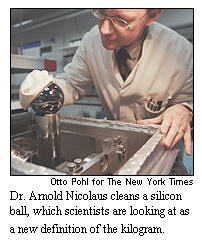Define A Kilogram The Basis of Measurement in Science
Latest News about Defining a Kilogram: Linking it to weight of quantum particles.
It’s the End of the Kilogram as We Know It (And I Feel Fine)
January 25, 2011
The speed of light may define a meter and atomic clocks may define a second, but a century-old cube of metal still defines the kilogram–at least, until scientists give this antique lump a 21st-century makeover.
As far as the kilogram is concerned, the year is still 1879, but scientists are meeting in London this week to discuss a change for this humble unit. As the Guardian reports:
“The kilogram is still defined as the mass of a piece of platinum which, when I was director of the International Bureau of Weights and Measures, I had in a safe in my lab,” said Terry Quinn, an organiser of today’s meeting. “It’s a cylinder of platinum-iridium about 39mm high, 39mm in diameter, cast by Johnson Matthey in Hatton Garden in 1879, delivered to the International Committee on Weights and Measures in Sevres shortly afterwards, polished and adjusted to be made equal in mass to the mass of the old French kilogram of the archives which dates from the time of the French Revolution.”
The problem with this dusty old cube is that it isn’t immune to aging: since 1879, it has shed 50 micrograms. In other words, if the President of the United States at the time–Rutherford B. Hayes–were to time travel to the present, he’d officially have more mass because it takes more of today’s kilograms to equal yesteryear’s kilograms–all because our standard is a vulnerable physical object. Adding to the confusion, other units–the newton, for example–rely on the kilogram and multiply the amorphous state of seemingly standard measurements.
Scientists, though, think they have an answer. As MSNBC reports:
“International consensus has been achieved, that in the near future the kilogram shall be redefined, based on a fixed value of the Planck constant,” Michael Stock, a physicist at the International Bureau of Weights and Measurements (BIPM), said in a statement. Stock said researchers have been conducting experiments that establish a link between mass and the Planck constant by comparing measurements of electrical and mechanical power.
Source:
http://blogs.discovermagazine.com/discoblog/2011/01/25/its-the-end-of-the-kilogram-as-we-know-it-and-i-feel-fine/?utm_source=feedburner&utm_medium=feed&utm_campaign=Feed%3A+DiscoverPhysicsMath+%28Discover+Physics+%26+Math%29&utm_content=My+Yahoo
Life is getting more and more abstract
A kilogram is actually a human defined weight. Now it is measured by a bar of metal an we need a more exact basis for scientific work. Now, scientists are changing the definition of a kilogram to the mass of an almost perfect silicon sphere, which can then be translated into abstract mathematical terms.
Of course, the rarification of such a basic measure as the kilogram into abstract mathematical terms, along with the subsequent rarification of all measurements into math symbols, may well have a profound impact of our civilization. I think of it as another step in the abstraction of all our lives and indeed our persons. Just think, our very individual essences have been abstracted into a DNA code, which, of course, can and has been expressed in mathematical terms and can be manipulated by computer operations. The territory and geography of the gelatinous mass of our brains is being, little by little, explored and entered into maps which can be, you guessed it, expressed abstractly and mathematically, as can the electrical impulses of our thoughts, emotions and basic operations of our body's life. Our thoughts and conversations are abstracted by our cell phones and sent in electrical codes through the ether, as are our IMs and e-mails. Music, too, which is such a big deal in our lives is, what, a construction of chords and tempos which are really mathematical expressions. And, so, we, are on a voyage, perhaps, to become similar to those abstract alien biengs, which had no physical forms, so beloved in episodes of Star Trek and other science fiction.
Welcome to the abstract kilogram.
Closeup of the roundest sphere in the world. The new kilogram sphere.


How much is a kilogram? (For non-metric readers, especially) This video will give you an unforgettable example.
What's a Kilogram and How do we know?
I am fascinated by the sources of everyday things like time (a cesium clock in Washington D.C.) and measurements such as the kilogram. So when I see something weighs a kilo I think of that bar of platinum and iridium in a vault in Paris that is the checkpoint for all kilograms in the world.
But now we're moving up in the measurement business, as you can read below. The Aussies are grinding two perfect silicon-28 balls weighing precisely just one kilogram. And from that, they'll figure out the number of atoms in a kilo and then it's all a matter of abstract mathematics rather than a bar in a vault. It had to happen in this day of computerized abstractions.
Read on:
The grind's almost over to forge two perfect balls
By Rob Taylor Thu Jun 14, 10:52 PM ET
CANBERRA (Reuters) - They will be the earth's roundest spheres, crafted by Australian scientists as part of an international hunt to find a new global standard kilogram.
Ever since scientists discovered that the current standard -- a bar of platinum and iridium held in a French vault since 1889 -- was slowly deteriorating, the search has been on for a replacement.
Using a single crystal of silicon-28 grown by Russian and German scientists over three years, a team of Sydney scientists and engineers will grind and polish two silvery balls, each weighing precisely one kilogram, with imperfections of less than 35 millionths of a millimeter.
"We are doing everything to really create a perfect object. It's not only near-perfect in roundness, but also the crystal purity, the atomic species and so on," project leader Walter Giardini told Reuters on Friday.
"Silicon is a very nice material to use that we understand well, makes good crystals and can be worked," said Giardini, from Australia's National Measurement Institute.
The two balls will take 12 weeks to create and, because they are made from a stable element, they will not fall victim to moisture, corrosion and contamination like the current kilogram standard, known as the International Prototype.
The spheres will be a step along the perfect kilogram road, with the project's ultimate aim to re-define the kilogram in terms of numbers of atoms, rather than an object open to damage from earthquake or environmental changes.
"The aim is not to change the value of the kilogram, but to ensure its stability for all future times," Giardini said. "It will no longer depend on an actual physical object and this is going to allow us to relate the mass to the individual atoms."
The project is a collaboration involving scientists from Russia, Germany, Italy, Belgium, Japan, the United States and Australia, in cooperation with the International Bureau of Weights and Measures.
On completion, the spheres will be measured for volume in Australia, Germany and Japan, then measured for mass. Belgian scientists will look at the molar mass of the crystal used to calculate the number of molecules in each sphere.
Australian scientists have the most expertise in grinding near-perfect spheres, having been turning them out for clients including NASA since the early 1990s.
"We have developed technology so that we can see what we are getting, whether they are slightly oval or flat. We are trying for an accuracy of two parts in 100 million," Giardini said.
Wikipedia definition and history of kilogram
How we know what a kilogram weighs today
[I wonder if someone could write a thriller about the meter-cylinder in vault in Paris being tampered with and all the weights of the world becoming wrong. Just a thought.]
Redefining the kilogram
Features: May 2004
The kilogram is the last remaining SI unit that is defined in terms of a material artifact, but two experiments are under way to find a more fundamental measure of mass.
IN A VAULT on the outskirts of Paris there is a small cylinder made of platinum and iridium that has the unique property that its mass can neither increase nor decrease. This property is not the result of new physics, however, because the object is over 100 years old. Rather, the unique properties of this cylinder arise because it is the international prototype of the kilogram. And the definition of the kilogram in the SI system of units states that “the kilogram is the unit of mass; it is equal to the mass of the international prototype of the kilogram”.
This means that the cylinder always has a mass of 1 kg, even if it gets “heavier” as a result of accreting dirt from the atmosphere, or “lighter” as a result of cleaning. One wide-reaching consequence of defining the kilogram in terms of a material object is that if the mass of this object changes, the values of all the other masses and mass-related quantities in the SI system will change as well. This is obviously not a good state of affairs.
The fact that the existing definition of the kilogram has lasted so long, and caused so few problems, is a tribute to the physicists and metallurgists who contributed to the birth of the SI system of units, and to those who now maintain it. The prototype kilogram is kept by the Bureau International des Poids et Measures (BIPM) in Sèvres, which takes great care with its storage and use.
The kilogram is occasionally taken out of its vault and used to calibrate the primary mass standards of each of the signatories of a diplomatic treaty known as the Metre Convention. Most countries in the industrialized world have signed the convention, and each signatory is entitled to a copy of the kilogram mass. The UK, for example, has copy number 18, which was one of the original copies fabricated in about 1894 - just five years after the prototype was made.
In each country a system is in place to ensure that all mass measurements can be traced back to the appropriate copy of the kilogram. At the National Physical Laboratory (NPL) in the UK we measure the mass standards of a small number of calibration laboratories, and these laboratories are then responsible for disseminating the results either to end users or to other calibration laboratories. This creates an unbroken chain of measurements linking the weighing scales in shops and the precision balances in universities and industry back to the national prototype, and therefore ultimately to the metal cylinder in the vault at Sèvres.
In the May issue of Physics World Ian Robinson at the National Physical Laboratory in the UK describes the search for a fundamental measure of mass in more detail.



